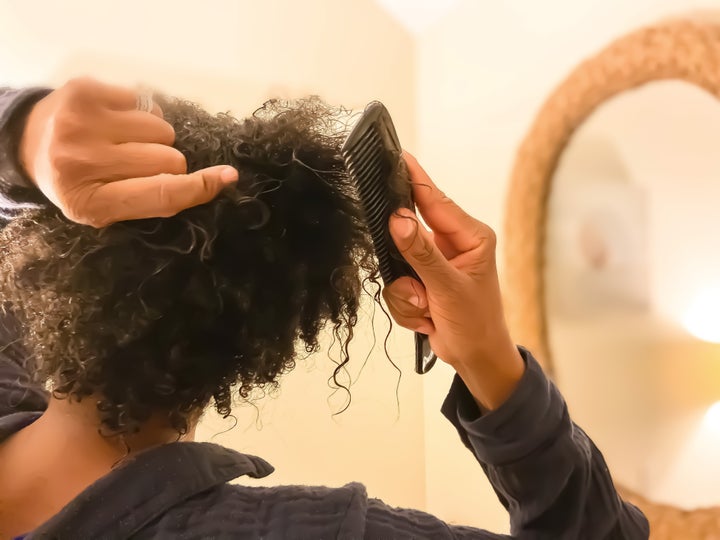It’s been 84 years (well, it feels like it) since lockdown began and if there’s one thing that’s not faring well right now, it’s our barnets.
People are once again resorting to DIY haircuts (yikes!) and trying everything under the sun to hide their roots on Zoom.
As part of the UK’s strategy to ease out of lockdown, hairdressers and barbershops won’t be reopening until April 12 at the earliest, prime minister Boris Johnson has said.
But even if there are weeks to wait, we’ve got your back – and barnet – as stylists and haircare experts share their top tips for controlling your lockdown locks and giving them a new lease of life during the next few months.
1. Give your hairdryer a day off (or two)
If you’re spending lots of time at home, this is a no-brainer. Caroline Sanderson, owner of Ego Hair Design in Inverness, says excess drying and styling – along with having the heating on all the time – will damage and dry out your hair.
“Try to limit the drying and use this time to look after your hair so that when you can make it to the salon again, your stylist has unlimited options,” she says.
Worried about attending that morning Zoom meeting with wet hair? Keep the camera off, it’s better for your hair and the planet.
2. Embrace your curls
If you have naturally curly or wavy hair, now’s the time to embrace it. This is because “curls, waves and any movement in the hair helps hide any unruly out-of-place hair”, including split ends and breakage, says Ricky Walters, director of Salon64. Giving the straighteners a rest will work wonders for your heat-damaged barnet.

3. Steer clear of the kitchen scissors
It can be tempting to reach for the nearest pair of scissors when your hair is making you look like Cousin Itt, but Emma Combe, ambassador for haircare brand Moo & Yoo, urges people not to cut their hair at home. “It may seem like a good idea, but we can guarantee you’ll regret it fairly quickly,” she says. “If you absolutely have to, only cut your fringe. Cut it dry, cut less than you think and below your fingers.”
Martin Quenault, salon director of KH Hair in Ashby, Leicestershire, agrees it’s not a good idea to trim your hair yourself, but he acknowledges desperate times call for desperate measures. If you want to have a go, get hold of some hairdressing scissors. “Kitchen scissors are a definite no-go,” he adds.
“I would only take a small amount off to keep it in shape, please don’t attempt a restyle,” he says. “Only cut your hair dry when doing it yourself, as if you do it wet, it will be much shorter when you’ve dried it.” He advises people to take small sections of hair and use the tips of the scissors to take the ends off and chip into the hair – “rather than just making blunt lines in your style”.
4. Change your parting
If you’ve got some serious roots showing or grey hairs you want to hide, Joanne Roe, a stylist at KH Hair’s Leicester salon, suggests avoiding a prominent parting. “Try a messy or zigzag parting, or no parting at all,” she says. “This will definitely help make them less visible.”
5. Make your own hair mask
For those with afro and curly hair, Katherine and Francessca Hagan, managing directors at ONaturalOils, recommend making a deep conditioning mask at home – especially as afro and curly hair is prone to dryness and breakage.
You’ll need: a plastic container, a mixing bowl, a small knife, a wooden spoon, a tablespoon, a teaspoon, half a banana (avoid using one that’s too ripe, as it will stick to your hair), your favourite deep conditioner, honey, and some hair oils.
- Peel and chop half a banana into 3 or 4 slices and place into the mixing bowl
- Add 2-3 tablespoons of your favourite branded deep conditioner into the bowl
- Then add a teaspoon of honey into the mix
- Add in a 1-2 teaspoons of your favourite oil blend
- Take your wooden spoon and mix it all together until the mixture in completely smooth
- Scoop the mix into your plastic container ready for use.
They recommend placing a shower cap over your hair, leaving the conditioner on for 20-30 minutes and applying low heat using a hooded dryer or a hairdryer before washing the mask out.
Regardless of hair type, Adele Clarke, owner of Spectrum Hair Company and Osmo Ikon brand ambassador, says you can use olive, coconut, avocado or castor oil to improve the health of your hair and scalp. “Massage them directly into your hair, or add to your everyday conditioner to make a deeper, more intense treatment.” This is especially great if you’ve ran out of serum.

Celebrity hair stylist Tom Smith says Asian hair types can sometimes be prone to frizz. “If this is the case, take the opportunity to use high moisture content hair masks at home, especially through the middle and the ends,” he says. “It’s a good idea to avoid the roots as this hair type tends to get oily more quickly due to the tightly closed cuticle on the outside of each hair strand.”
6. Embrace the up-do
Stylists everywhere are recommending giving your hair a break from heat styling by wearing it up and washing it less while we’re at home. You could try a plait, which will hide split ends and out of shape layers, says Ricky Walters. Or a snatch ponytail – pulled tightly and worn high on the crown, it’s a ponytail with mega attitude. Think Ariana Grande.
7. Make DIY dry shampoo
If buying a new bottle of Batiste has been low on your priorities lately, you can create your own dry shampoo at home, says Clarke.
“Mix corn/rice starch and baking soda with a little cocoa for darker hair and one drop of lavender oil, apply with a makeup brush and leave in for a few minutes,” she says. “Brush out and it will freshen your roots up a treat. Maybe add a little of your favourite smelling talc.”
8. See off those split ends
The only real way to get rid of split ends is to undergo regular trims, but there are a few ways you can protect your hair and repair some of the damage, says Jon Hala, who owns a salon in Jubilee Place Canary Wharf.
First up, take a break and don’t use heat on your hair. Next, remember to treat your hair gently – “don’t tug at it no matter how fed up you get with a knot,” he says. If you do, it can worsen the split and make hair more fragile. And thirdly, treat your hair to a weekly deep condition.
“It’s important to use good products that bolster and protect strands,” he says. “Next time you’re buying haircare essentials, look out for ones that are known for targeting split ends. Ensure these are silicone free as they work extra hard to boost moisture and protect strands from further damage.”
9. Do a weekly deep condition
Like Hala, Tatiana Karelina, a hair extension specialist and stylist, praises the power of deep conditioning. And you can do it without making a hair mask. “Apply a generous amount of conditioner on damp hair, comb it with a wide tooth comb, wrap your head with cling film and a towel, leave for 20-30 minutes and then rinse and enjoy your silky smooth hair,” she says.
“Hair of all types, textures, and tints would benefit from this treatment. But it’s particularly amazing for textured curly hair as it tends to get dry and brittle a lot easier.”

10. Style your hair differently
If you’ve got shorter hair and it’s growing into something resembling a mushroom, hair stylist Neil Moodie suggests styling it a bit differently.
“A side parting slick look can be good – just some water and a bit of gel is all you need, or even scrape it back and create some height and texture on the crown,” he suggests. Even something as simple as tucking hair behind your ears can give it new shape.
For afro hair, he recommends cornrowing the hair when it’s growing out, or adding a headband around the front hairline. “Leaving conditioner on the hair after shampooing and creating some twists in the hair can be a good way to control a growing out afro texture,” he adds.
11. Accessorise!
If you’re bored of the same old hairstyle, Joanne Roe, from KH Hair’s Leicester salon, recommends investing in accessories for a quick upgrade. “Maybe try a beautiful embellished pin,” she says. “This will offer a distraction to whatever is happening with your roots. If you’re looking for a complete coverage, try a chic scarf.
Moodie adds: “A headband around the front of the hair can be cute on a grown out, short hair cut – whether it be slicked back or textured.”
12. Opt for a one-level cut
Mark Maciver, owner of SliderCuts in east London, has some tips for making short afro hair look neater. First up: a one-level haircut.
“If you’re okay with a flat hairstyle, you can get away with most styles,” he says. “If it’s a level 1, 2 or 3, you just need to make sure you go against the grain, the opposite direction that your hair grows. This will make it a flush cut, even cut all around.” There are tutorials for beginners on his Instagram and YouTube.
Alternatively if you have a lot of volume in your hair and you want to look a little bit neater, you can do a technique called compressing. “Get a type of holding cream, and use a headscarf, headwrap or do-rag and apply the cream then put the rap on your head and that will help to compress whatever is there to make it look neater shorter and tidier,” he says.
13. Master the art of the blow dry
Fancy trying an at-home blow dry? Jessica Neil, stylist at KH Hair West Bridgford, Nottingham, says good condition hair is key to getting it right.
On freshly washed, towel-dried hair, prep for your blow dry using volumising and anti-frizz products, as well as heat protection. Next, you’ll need to section your hair. “This is very important,” says Neil, “as you won’t be able to dry your hair as well and create the shape you are after without sectioning the hair.”
Start at the nape, leaving a three-inch section down, and clip the rest of the hair out the way. Using a medium/large round brush, place your hair over the top of the brush and keep it in place. Set the dryer to a medium heat and apply over the root area, wafting it gently. Once the root is 95% dry, move the brush down through the hair to the mid-lengths and ends, creating a bend on the ends.
Once the first section is done, continue taking two-inch sections, focusing on the roots first until they’re 95% dry, then moving the brush down. When you’re ready to start on the front, you need to change technique. “You will now be holding the round brush directly on top of your head, working away from your face,” she says. “Again, place the hair in the fringe/hairline area on top of the brush as normal and dry your roots to 95%. Then, work the brush through to the ends, moving the brush upwards and backwards until completely dry.”
Once the hair is totally dry, run your fingers through it to work that shape and finish off with a spritz of hairspray – “nothing too heavy as this will make your gorgeous new blow dry sticky”.
